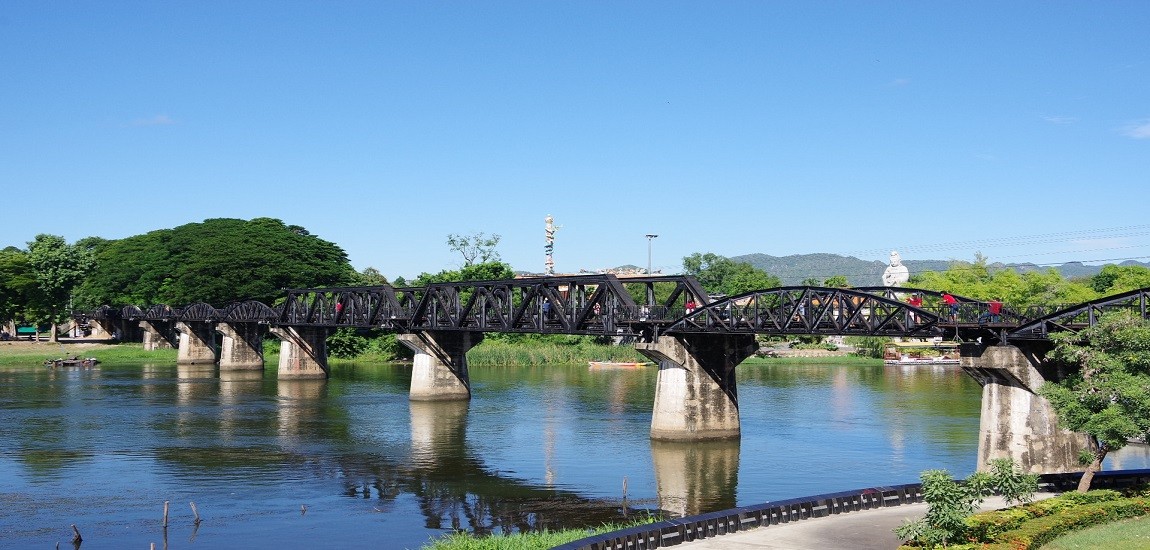
Thailand’s Historic Death Railway and River Kwai Bridge
The renowned River Kwai Bridge and the Death Railway serve as haunting reminders of a sad chapter in history. These historical landmarks in Kanchanaburi, Thailand, draw visitors from all over the world who want to learn about the region's traumatic history while also enjoying its natural beauty. This article looks into the fascinating history of the Death Railway and the River Kwai Bridge, as well as their importance in modern-day tourism.
History of the Death Railway and River Kwai Bridge
The Death Railway, also known as the Burma Railway, was built by forced labor under Japanese control during World War II. Its construction attempted to create a supply line between Thailand and Burma, supplying Japanese forces with vital resources. Due to harsh conditions, infections, and starvation, the project claimed the lives of thousands of Allied prisoners of war and local laborers.
The River Kwai Bridge, famously depicted in literature and cinema, is an important aspect of this railway's history. The original wooden bridge was built in 1943, but it was eventually replaced with a steel construction. The bridge spans the Kwai Yai River and stands as a sad reminder of the hardships suffered by those who built it.
Tourism Aspects: An Immersive Historical Experience
The Death Railway and the River Kwai Bridge have grown into popular tourist attractions that provide a unique blend of history, natural beauty, and cultural discovery.
Historical Significance: The historical significance of these locations draws visitors. Museums and displays, such as the Thailand-Burma Railway Centre, offer in-depth insights into the railway's construction and the experiences of those who lived through it. Visitors can acquire a comprehensive knowledge of the sacrifices made during the war.
Commemorative Memorials: The Kanchanaburi War Cemetery and the Don Rak War Cemetery serve as sombre memorials to those who died while the railway was being built. Tourists pay their respects and think on the significance of the events that occurred here.
Scenic Beauty: Beyond its melancholy background, the Death Railway region provides stunning natural scenery. The lush foliage, meandering riverbanks, and flowing waterfalls provide a relaxing respite for travellers looking for peace and quiet amid historical exploration.
River Kwai Bridge: The renowned bridge itself is breathtaking. Visitors can walk along its tracks and take beautiful photos against the backdrop of the River Kwai. The occasional passing train lends a realistic touch to the experience.
Cultural Immersion: Visitors can interact with the local population, enjoy traditional Thai cuisine, and visit neighboring temples and marketplaces. This cultural exchange enhances the whole vacation experience.
Sustainable Tourism and Remembrance
Efforts have been taken to ensure that tourism in the vicinity of the Death Railway and the River Kwai Bridge is courteous and educational. Guided tours and informational displays highlight the historical context and significance of these sites, encouraging visitors to feel empathy and understanding.
Tourism has also benefited local communities by creating jobs and economic possibilities. Initiatives that promote responsible tourism while preserving the memories of the past are critical to maintaining the delicate balance between recollection and enjoyment.
The Death Railway and River Kwai Bridge highlight a crucial episode in world history and allow travellers to pay tribute to the lives lost while appreciating the region's enduring beauty. These sites have become significant attractions that educate, commemorate, and inspire through a combination of historical understanding, scenic awe, and cultural involvement. Travelers who walk the roads of history not only increase their grasp of history, but also contribute to the preservation of a solemn legacy.